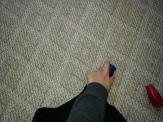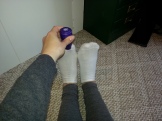How old do you have to be to compose music? 18? 12? 5? Younger?

Mozart was only five years old when he wrote these first compositions.
My son isn’t yet five and he writes compositions, too… but he’s no musical prodigy. He is not as proficient in music playing or writing as Mozart was. He can’t yet articulate his musical thoughts on paper, but he can improvise musically with words, rhythm, and melody.
Everyone who has been around music and is allowed to experiment with music has the ability to do this. With proper encouragement, every child can improvise. So, how did we get to this point?
- SING. All the time. Play instruments or just play rhythms by clapping or patting or beat-boxing. What you will find is that your child will start repeating the things you do at different times.
- Let them experiment, even if it is annoying. Sometimes they will sing loudly or sing the same word over and over. Try to put up with it. You can try to redirect their efforts or ask them to try it more softly, but don’t tell them to stop!
- Start by giving them ideas to riff on- start a silly song about what you are doing and give them a turn to improvise. They will probably start by changing the words to a tune they already know, which is ok.
- Provide an accompaniment for them or have them provide an accompaniment for you. Beat-boxing is a fun way to do this. This shows them you can improvise something without words and is an easy way to practice ensemble singing/playing.
- Make any time a good time to improvise! Do it in the car, in the bathtub, at dinner…
- Let them play at conductor and tell you what the song or piece should sound like. Have them try to describe it to you as best as they can and try to make their composition come to life.
- As they get older, start introducing technology to record themselves. They will spend so much time playing back their songs, and with programs like the iOS’s Garageband, they can add drums or other instruments to their recordings and have fun making it sound new and different.
- As children progress in their musical learning, they can make composition maps- that can be anything from crayon drawings of what it sounds like, to prompts like “high, major, duple, du de du de, soft, fast.”
- When your children learn music reading and writing, you can have them compose on free printable staff paper, like that found on this webpage: http://www.blanksheetmusic.net/
The most important thing is to find time to make music together and have music-making be fun and feel judgement-free. Perfecting a composition or figuring out how to express verbally or visually what you hear in your head can be frustrating. Make them feel safe and not on-the-spot when composing and improvising. Allow them to see you make mistakes and laugh it off. Music-making at home doesn’t need to be perfect to be enjoyable.
How do you improvise or compose with your family?











